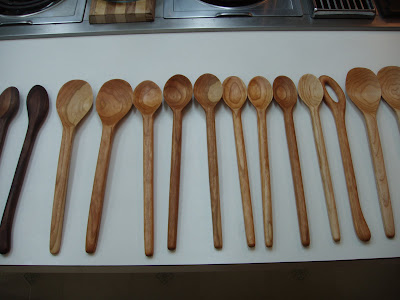Tuesday, April 27, 2010
You should read this book
The best dictionary in the world

At least one of them. The Oxford English Dictionary. I got one at the second-hand bookstore for $100. And you didn't. Sorry.
This is the compact edition, where they put four pages on one page. And yes, it is a lousy picture. This was on my old camera.
The awesome door gets cut in half.

Things I have made, part 3
Friday, April 23, 2010
Now for some words - a poem by me.
There is no hell
Set aside for those
That cannot spell.
Things I have made, part 2: Wood rocks!
So, Laughter's spoons below may be cool, but they take a LOT of work. These don't.
I got the idea to make wooden rocks from some pictures I saw on the internet - hardwood chunks, cut and sanded into faceted shapes suitable for stacking. So I made some. I had three kinds of wood to work with - apricot, from some trees in our side yard that didn't make it; cypress, from the front yard; and sycamore, from the back yard. After making faceted shapes and playing with them (I let the kids play with them too), I decided to round some off to look more like river rocks.
These are made from apricot and finished with polyurethane.

After I finished those and made the little basket thingy, I thought they would look better in a clear bowl. So see below:

These are sanded but not finished. The lighter colored pieces are cypress. They smell great, but the pitch in the center makes them impossible to polyurethane. I have done a few with wax, and that works well.
Here is another view of the same pile:

Thursday, April 22, 2010
By the light of the silvery moon...




Thoughts on materials: I made all of these out of 3/4 inch thick lumber. Maple is by far the best. It is hard to carve, but the tight smooth grain gives the best finish and the utensils don't get dinged up as fast. Cherry and Walnut both made some nice looking spoons. They are softer than the Maple, so the work went a lot faster, but they do ding up faster. Poplar is the least expensive choice. It is also pretty soft, but has a nice smooth, tight grain. It works fast and looks okay at the end. I tried Ash just because I had some. I won't waste my time with it again. Hard, brittle, splinters like crazy, and huge open grain. Good for baseball bats, not good for spoons.
Tools- The first few spoons I made with nothing more than a pocketknife and sandpaper. It was slow going. When I decided to make a bunch, I bought a carving gouge and a set of swedish carving knives. I have not used the pocket knife since. I cut out all the blanks with a coping saw.
The best part of the project was giving them away, but I had a lot of satisfaction sitting in front of the TV with a box to catch wood chips and just whittling away (include vacuum cleaner on your tools list if doing this).
Friday, April 16, 2010
Things I have made, part 1

This is a menorah I made for a friend at work. I used aromatic cedar and I cut it out on my scroll saw. The design was inspired by several items of Judaica and is meant to evoke the Jerusalem skyline of centuries past. I think it turned out quite nice. The holes for the candles are drilled on top and you can't see them in this picture.
Thursday, April 15, 2010
Women Named in the Book of Mormon
Why so few women mentioned by name? I don’t know. But if you count the names in the Pronouncing Guide (343), subtract the seven women’s names, the place names, and the other names, you find 206 names remaining. By going through the list and listing those that are readily recognizable as either good guys or bad guys, I come up with 32 percent bad guys and 68 percent good guys. The percentages are much different for the women. Five of the six (or six of the seven) are righteous, giving us 83 (or 86) percent of the women as righteous.
Does this mean anything? I doubt it.
Wednesday, April 14, 2010
Awesome door for a bench
This is a door. I got it at a store that sells salvaged construction materials. I plan on making a bench out of it. This picture was taken after I sanded the thick brown paint off of the flat parts. The carved panels required a bit more work with stripper and brushes and steel wool.


